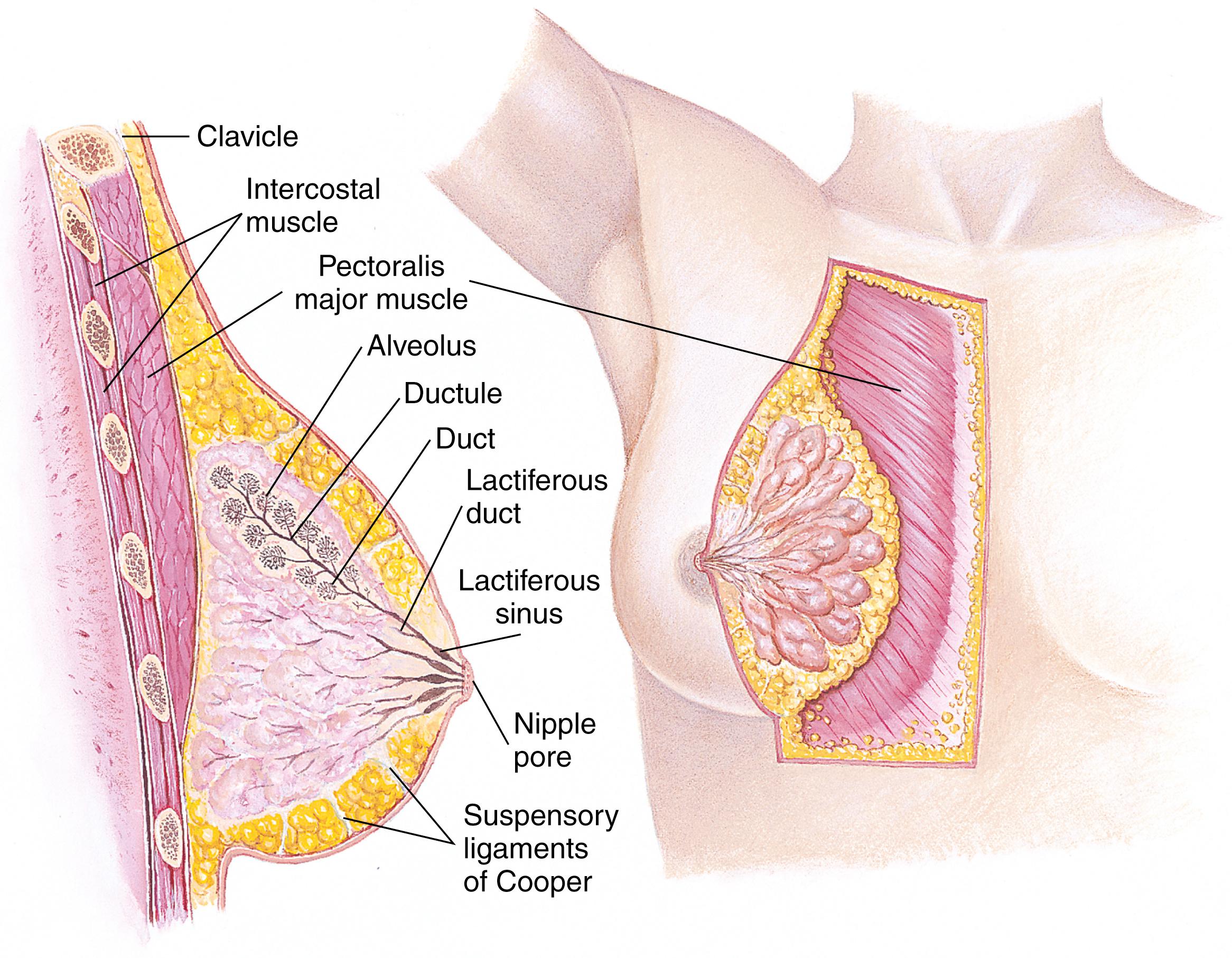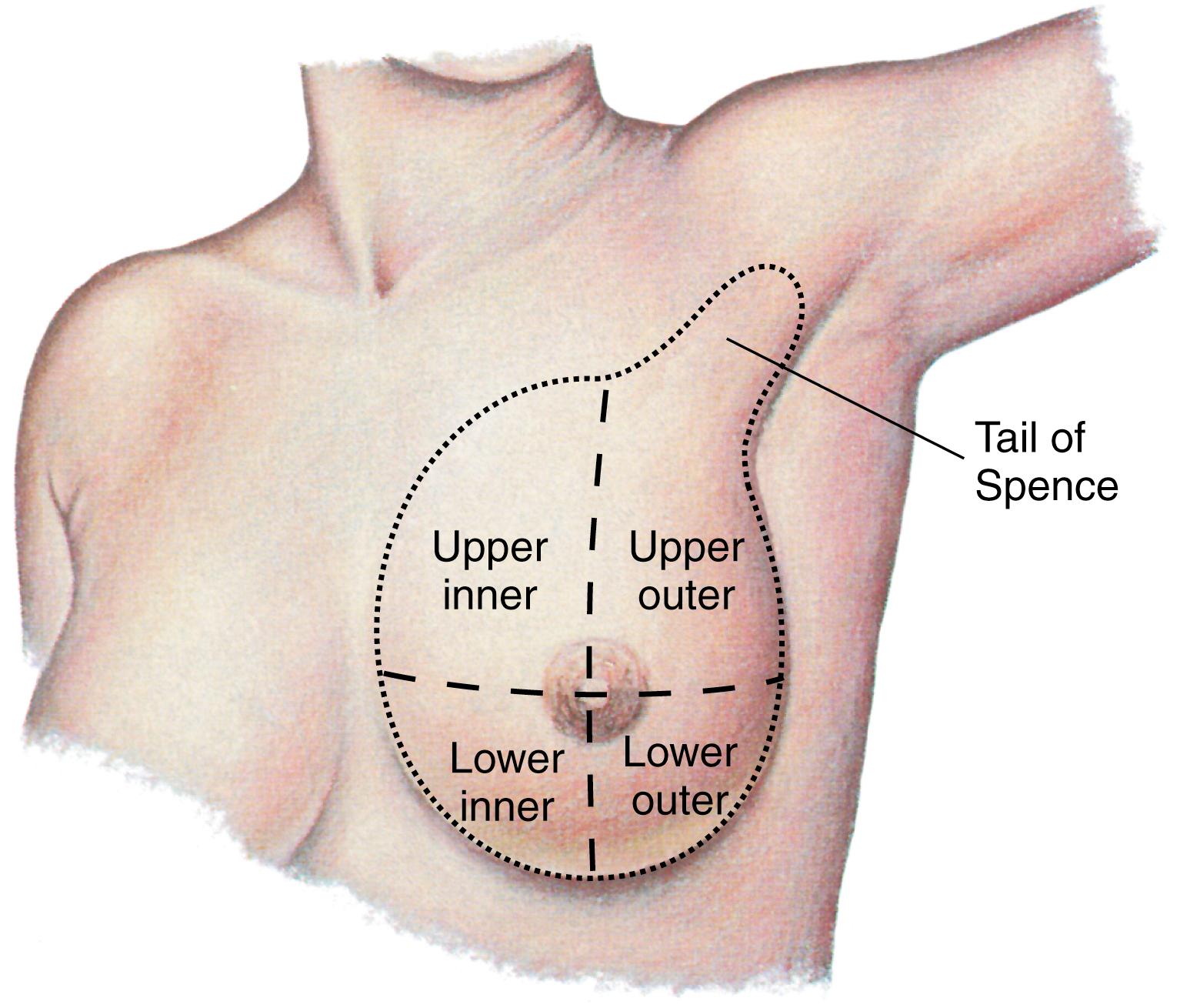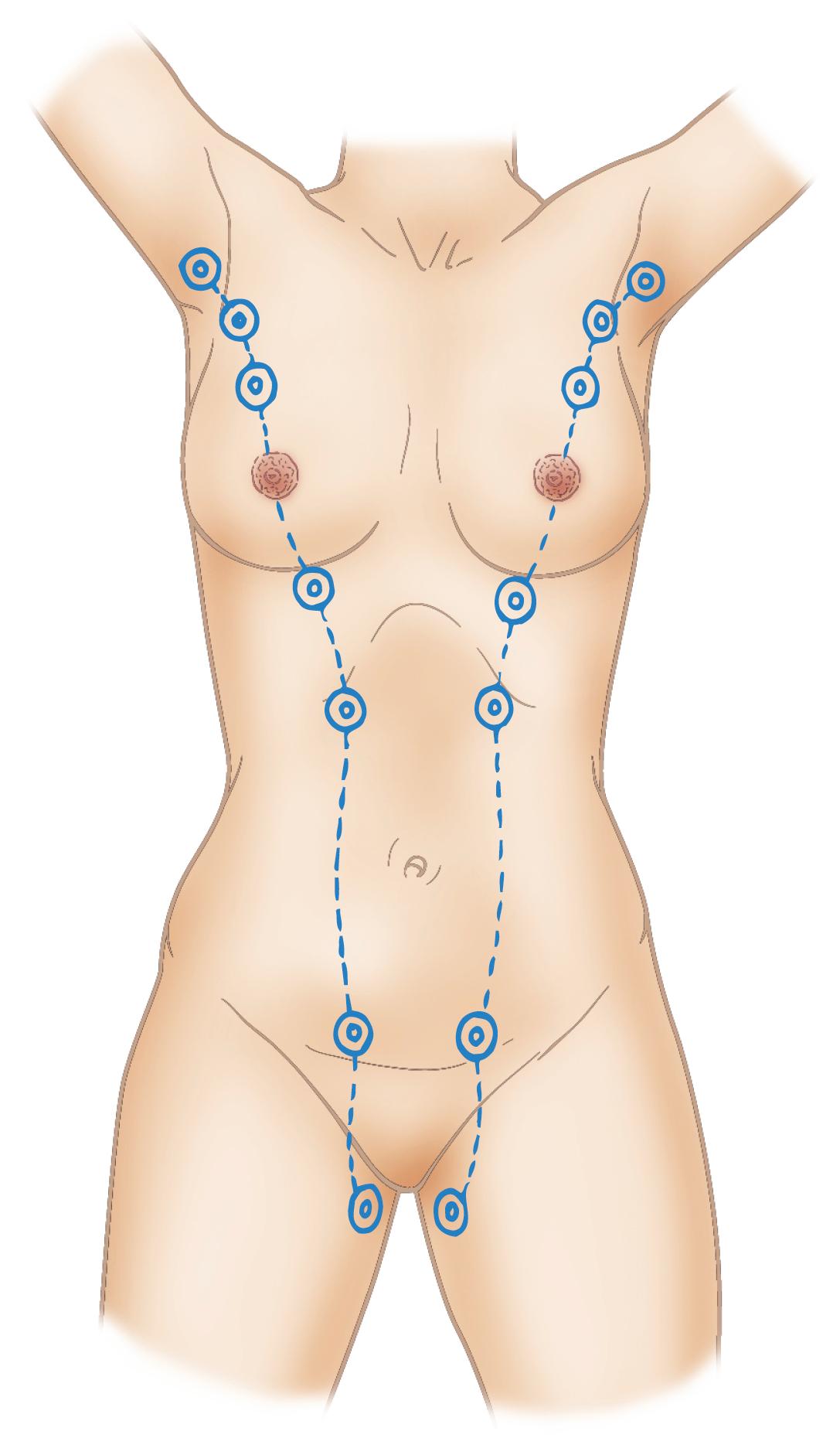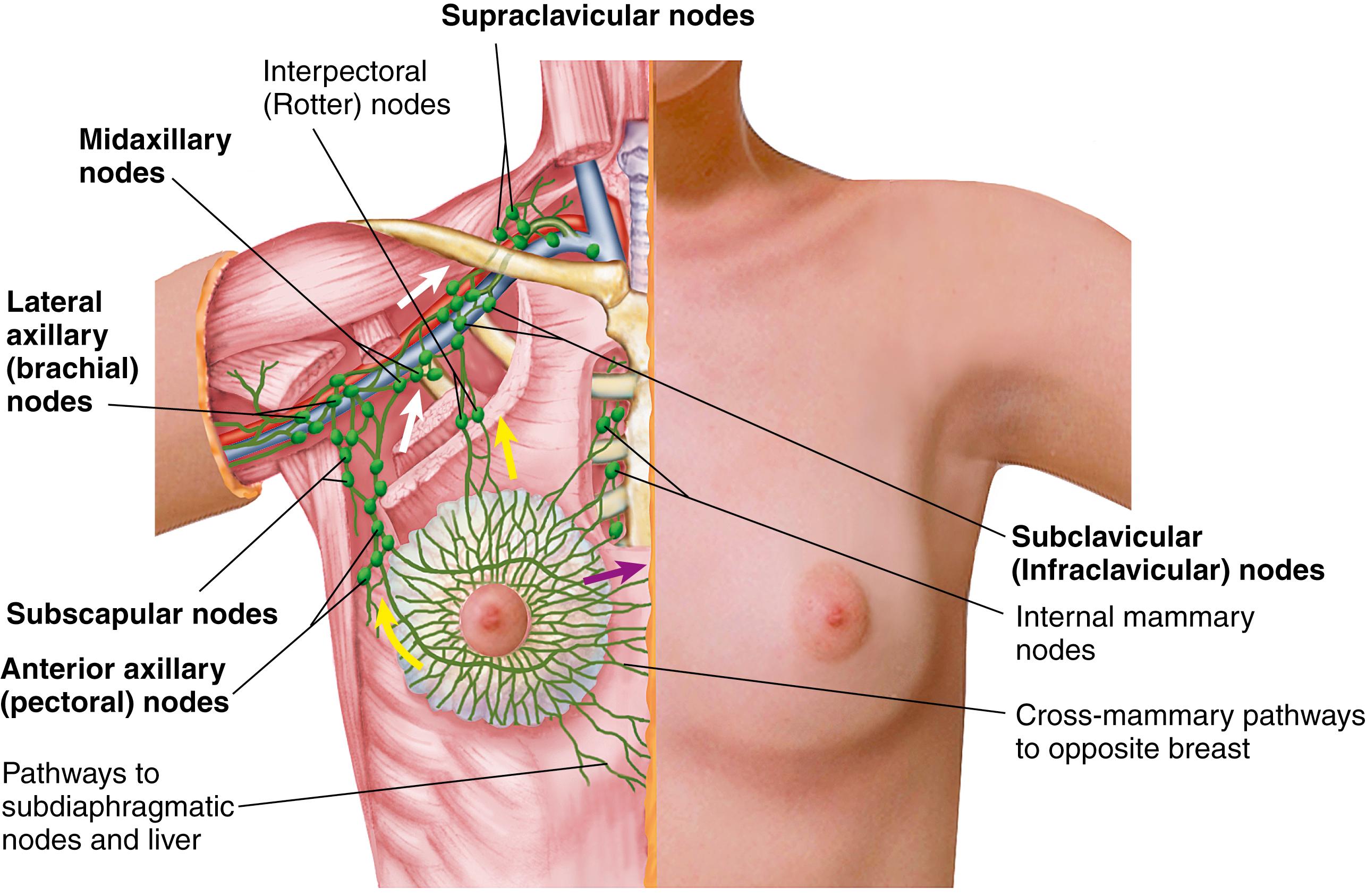Physical Address
304 North Cardinal St.
Dorchester Center, MA 02124
The breast examination is typically performed when a patient presents with a specific breast concern, as a follow-up to an abnormal examination or increased risk for breast cancer, or as part of a routine health visit. Examination of the breasts includes examination of the axillae and relevant lymph node chains. A major focus of the examination in adults is identification of breast masses, skin, or vascular changes that could indicate malignancy. Breast examination is important in children for Tanner staging or sexual maturity rating as well as part of an evaluation for premature or delayed puberty.
For all patients:
Inspect with patient seated. Compare breasts for:
Size
Symmetry
Contour
Retractions or dimpling
Skin color and texture
Venous patterns
Lesions
Inspect both areolae and nipples and compare for:
Shape
Symmetry
Color
Smoothness
Size
Nipple inversion, eversion, or retraction
Supernumerary nipples
For patients with substantial breast tissue:
Reinspect breasts with the patient in the following positions:
Arms extended over the head or flexed behind the neck
Hands pressed on hips with shoulders rolled forward
Seated and leaning forward
In recumbent position
Perform a chest wall sweep.
Perform bimanual digital palpation.
For all patients:
Palpate for lymph nodes in the axilla, down the arm to the elbow, and in the axillary, supraclavicular, and infraclavicular areas.
Palpate breast tissue with patient supine using light, medium, and deep pressure. Depress the nipple into the well behind the areola.
In this chapter, the terms “female,” “male,” “female breasts,” and “male breasts” are used in order to differentiate between the composition, development, and maturation of breast tissue in patients assigned as female or male at birth, respectively. This becomes important to the examination and health of patients who, for example, are transgender male or non-binary, but still have “female” breast tissue. Additionally, “female breasts” refer to persons with substantial breast tissue, as breast tissue changes may also occur as a result of hormonal or surgical intervention.
The breasts are paired mammary glands located on the anterior chest wall, superficial to the pectoralis major and serratus anterior muscles ( Fig. 17.1 ). In female breasts, the breast extends from the second or third rib to the sixth or seventh rib and from the sternal margin to the midaxillary line. The nipple is located centrally, surrounded by the areola. The male breast consists of a small nipple and areola overlying a thin layer of breast tissue.

The female breast is composed of glandular and fibrous tissue as well as subcutaneous and retromammary fat. The glandular tissue is arranged into 15 to 20 lobes per breast that radiate about the nipple. Each lobe is composed of 20 to 40 lobules, and each lobule consists of milk-producing acinar cells that empty into lactiferous ducts. These cells are small and inconspicuous in nonpregnant, nonlactating women. A lactiferous duct drains milk from each lobe onto the surface of the nipple.
The layer of subcutaneous fibrous tissue provides support for the breast. Suspensory ligaments (Cooper ligaments) extend from the connective tissue layer through the breast and attach to the underlying muscle fascia, providing further support. The muscles forming the floor of the breast are the pectoralis major, pectoralis minor, serratus anterior, latissimus dorsi, subscapularis, external oblique, and rectus abdominis.
Vascular supply to the breast is primarily through branches of the internal mammary artery and the lateral thoracic artery. This network provides most of the blood supply to the deeper tissues of the breast and to the nipple. The subcutaneous and retromammary fat that surrounds the glandular tissue constitutes most of the bulk of the breast and gives the breast its soft consistency. The proportions of each of the component tissues vary with age, nutritional status, pregnancy, lactation, and genetic predisposition.
For the purposes of examination, the breast is divided into four quadrants and a tail ( Fig. 17.2 ). The greatest amount of glandular tissue lies in the upper outer quadrant. Breast tissue extends from this quadrant into the axilla, forming the tail of Spence. In the axillae, the mammary tissue is in direct contact with the axillary lymph nodes.

The nipple is located centrally on the breast and is surrounded by the pigmented areola. It is composed of epithelium that is infiltrated with circular and longitudinal smooth muscle fibers. Contraction of the smooth muscle, induced by tactile, sensory, or autonomic stimuli produces erection of the nipple and causes the lactiferous ducts to empty. Tiny sebaceous glands may be apparent on the areola surface (Montgomery tubercles or follicles). Hair follicles may be present around the circumference of the areola. Supernumerary nipples or breast tissue are sometimes present along the mammary ridge that extends from the axilla to the groin (see Fig. 17.10 ).

Each breast contains a lymphatic network that drains the breast radially and deeply to underlying lymphatics. Superficial lymphatics drain the skin, and deep lymphatics drain the mammary lobules. Table 17.1 summarizes the patterns of lymph drainage.
| Area of Breast | Drainage |
|---|---|
| Superficial | |
| Upper outer quadrant | Scapular, brachial, intermediate nodes toward axillary nodes |
| Medial portion | Internal mammary chain toward opposite breast and abdomen |
| Deep | |
| Posterior chest wall and portion | Posterior axillary nodes (subscapular) of the arm |
| Anterior chest wall | Anterior axillary nodes (pectoral) |
| Upper arm | Lateral axillary nodes (brachial) |
| Retroareolar area | Interpectoral (Rotter) nodes into the axillary chain |
| Areola and nipple | Midaxillary, infraclavicular, and supraclavicular nodes |
The complex of lymph nodes, their locations, and direction of drainage are illustrated in Fig. 17.3 . The axillary nodes are more superficial and are accessible to palpation when enlarged. The anterior axillary (pectoral) nodes are located along the lower border of the pectoralis major, inside the lateral axillary fold. The midaxillary (central) nodes are high in the axilla close to the ribs. The posterior axillary (subscapular) nodes lie along the lateral border of the scapula and deep in the posterior axillary fold, whereas the lateral axillary (brachial) nodes can be felt along the upper humerus.

The breast evolves in structure and function throughout life. Childhood and preadolescence represent a latent phase of breast development. Thelarche (breast development) represents the first sign of puberty in females. Breast development is classified using the five Tanner stages, also known as sexual maturation rating, as discussed in Chapter 8 .
In using the Tanner system to stage breast development, it is important to note temporal relationships. It is unusual for the onset of menses to occur before stage 3. About 25% of females begin menstruation at stage 3. Approximately 75% are menstruating at stage 4 and are beginning to establish a regular menstrual cycle. About 10% do not begin to menstruate until stage 5. The average interval from the appearance of the breast bud (stage 2) to menarche is 2 years. Breasts develop at different rates in the individual, which can result in temporary asymmetry. Reassurance is often necessary. Delay in puberty for non-binary, transgender, or intersex children through pubertal blockers limits or stops breast development and stops menstruation.
Striking changes occur in the breasts during pregnancy. In response to luteal and placental hormones, the lactiferous ducts proliferate and the alveoli increase extensively in size and number, which may cause the breasts to enlarge two to three times their pre-pregnancy size. The increase in glandular tissue displaces connective tissue, and the breasts become softer and looser. Toward the end of pregnancy, as epithelial secretory activity increases, colostrum is produced and accumulates in the acinar cells (alveoli).
The areolae become more deeply pigmented and their diameter increases. The nipples become more prominent, darker, and more erectile. Montgomery tubercles often develop as sebaceous glands hypertrophy.
Mammary vascularization increases, causing veins to engorge and become visible as a blue network beneath the surface of the skin.
In the first few days after delivery, small amounts of colostrum are secreted from the breasts. Colostrum contains more protein and minerals than does mature milk, as well as antibodies and other host resistance factors. Milk production replaces colostrum 2 to 4 days after delivery in response to surging prolactin levels, declining estrogen levels, and the stimulation of sucking. As the alveoli and lactiferous ducts fill, the breasts may become full and tense. This, combined with tissue edema and a delay in effective ejection reflexes, can produce breast engorgement.
At the termination of lactation, involution occurs over a period of about 3 months. Breast size decreases without loss of lobular and alveolar components; the breasts rarely return to their pre-lactation size.
After menopause, glandular tissue atrophies gradually and is replaced by fat. The inframammary ridge at the lower edge of the breast thickens. The breasts tend to hang more loosely from the chest wall as a result of the tissue changes and relaxation of the suspensory ligaments. The nipples become smaller and flatter and lose some erectile ability.
The skin may take on a relatively dry, thin texture. Loss of axillary hair may also occur.
For each of the symptoms or conditions discussed in this section, targeted topics to include in the history of the present illness are listed. Responses to questions about these topics help fully assess the patient’s condition and provide clues for focusing on the physical examination and the development of an appropriate diagnostic evaluation. Questions regarding medication use (prescription and over-the-counter preparations) as well as complementary and alternative therapies are relevant for each.
Temporal sequence: onset gradual or sudden; duration; persistent or intermittent
Relationship to menses: timing, severity
Character: stinging, pulling, burning, drawing, stabbing, aching, throbbing; unilateral or bilateral; localization; radiation
Associated symptoms: lump or mass, discharge from nipple
Contributory factors: skin irritation under breasts from tissue-to-tissue contact or from rubbing of undergarments; strenuous activity; recent injury to breast; use of breast binders
Medications: hormones or bioidentical hormones; oral contraceptives
Temporal sequence: length of time since lump first noted; persistent or intermittent; relationship to menses
Symptoms: tenderness or pain (characterize as described previously); dimpling or change in contour
Changes in lump: size, character, relationship to menses (timing or severity)
Associated symptoms: nipple discharge or retraction, tender lymph nodes
Medications: hormones or bioidentical hormones
Character: spontaneous or provoked; unilateral or bilateral; onset gradual or sudden; duration, color, consistency, odor, amount
Associated symptoms: nipple retraction; breast lump or discomfort
Associated factors: relationship to menses or other activity; recent injury to breast
Medications: contraceptives, hormones, phenothiazines, digitalis, diuretics, steroids
History of hyperthyroidism, testicular cancer, Klinefelter syndrome
Medications: cimetidine, omeprazole, spironolactone, antiandrogens (finasteride), human immunodeficiency virus (HIV) medications (efavirenz), some chemotherapy agents, some antihypertensives, some antipsychotics, estrogen
Treatment for prostate cancer with antiandrogens or gonadotropin-releasing hormone analogs
Use of hormones, anabolic steroids, marijuana
Previous breast disease: cancer, fibroadenomas, fibrocystic changes
Known BRCA1, BRCA2, or other genetic mutation; known hereditary cancer syndrome (hereditary nonpolyposis colorectal cancer [HNPCC], Li-Fraumeni syndrome, or Cowden syndrome)
Gender identity: e.g., female, male, non-binary, transgender woman, transgender man, sex assignment at birth
Previous other related cancers: ovarian, colorectal, endometrial
Surgeries: breast biopsies, aspirations, implants, reductions, mastectomies, reconstructions, oophorectomy
Risk factors for breast cancer (see Risk Factors: “Breast Cancer”)
Mammogram and other breast imaging history: frequency, date of last imaging, results
Menstrual history: first day of last menstrual period; age at menarche and menopause; cycle length, duration, amount of flow, and regularity; associated breast symptoms (nipple discharge; pain or discomfort)
Pregnancy: age at each pregnancy, length of each pregnancy, date of delivery or termination
Lactation: number of children breast-fed; duration of time for breast-feeding; date of termination of last breast-feeding; medications used to suppress lactation
Menopause: onset, course, associated problems, residual problems
Use of hormonal medications: name and dosage, reason for use (contraception, menstrual control, menopausal symptom relief; gender-affirming treatment), length of time on hormones, date of termination
Other medications: nonprescription or prescription; hormones (estrogen, progesterone), selective estrogen receptor modulators (SERMS) (tamoxifen, raloxifene), aromatase inhibitors (e.g., anastrozole, letrozole, exemestane); silicone injections
Age: Risk increases with aging.
Gender: Higher incidence in female breasts. Transgender men who have not had bilateral mastectomies remain at risk for developing breast cancer.
Genetic risk factors: Patients with female breasts with an inherited BRCA1 or BRCA2 mutation have a 45% to 80% chance of developing breast cancer during their lifetime compared with the average risk of about 12%. Other inherited mutations can increase risk, but to a lesser degree.
Personal history of breast cancer: Cancer in one breast increases risk of developing a new cancer in the other breast.
Family history of breast cancer: One first-degree relative (parent, sibling, child) with breast cancer approximately doubles the risk; two first-degree relatives increase the risk threefold.
Certain benign breast conditions: Atypical hyperplasia with atypia or lobular cancer in situ (LCIS) substantially increases breast cancer risk. Proliferative lesions without atypia may increase risk slightly. Fibrocystic changes without proliferative changes do not affect breast cancer risk.
Race: Whites are higher risk than other racial/ethnic groups.
Previous breast radiation: Radiation therapy to the chest area as treatment for another cancer (such as Hodgkin disease or non-Hodgkin lymphoma) as a young adult significantly increases risk for breast cancer.
Menstrual periods: Menarche before age 12 or menopause after age 55 slightly increases risk.
Breast density: Breast tissue may be dense or fatty; older women whose mammograms show more dense tissue are at 1.2 to 2 times the risk.
Diethylstilbestrol (DES) therapy: Patients who received DES in the 1940s through the 1960s during their pregnancies have a slightly increased risk. Patients with female breasts who were exposed to DES in utero may have a slightly increased risk of breast cancer after age 40.
Childbirth: Nulliparity or late age at birth of first child (after age 30) is associated with an increased risk.
Hormone therapy: Use of combined estrogen and progesterone hormone replacement therapy (HRT) after menopause (more than 4 years of use) increases risk. The risk for transgender women taking estrogen hormones for at least 5 to 10 years is uncertain.
Alcohol: Risk increases with amount of alcohol consumed.
Obesity and high-fat diets: Obesity is associated with an increased risk, especially after menopause. Having more fat tissue can increase estrogen levels and increase the likelihood of developing breast cancer.
Lack of physical activity: Patients with female breasts who are physically inactive throughout life may have an increased risk of breast cancer.
A solitary breast mass that is hard, fixed, and accompanied by other physical symptoms such as tethering, retraction, flattening or peau d’orange is cancer until proven otherwise. The patient’s assessed risk for breast cancer in the presence of those findings is irrelevant. Most breast cancers occur in women without additional risk factors or a family history.
Breast cancer: primary relatives, secondary relatives; type of cancer; age at time of occurrence; treatment and results; known BRCA1, BRCA2, or other mutation
Other cancers: ovarian, colorectal, known hereditary cancer syndromes (breast-ovarian cancer syndrome, HNPCC, Li-Fraumeni syndrome, or Cowden syndrome)
Other breast disease in relatives: type of disease; age at time of occurrence; treatment and results
Age
Breast support used with strenuous exercise or sports activities
Amount of caffeine intake and breast tissue response (pain, fibrocystic changes)
Breast self-awareness: frequency, at what time in the menstrual cycle
Use of alcohol, daily amounts
Use of anabolic steroids or marijuana
Sensations: fullness, tingling, tenderness
Presence of colostrum and knowledge about how to care for breasts and nipples during pregnancy
Use of supportive bra
Knowledge and information about breast-feeding
Plans to breast-feed, experience, expectations, concerns
Become a Clinical Tree membership for Full access and enjoy Unlimited articles
If you are a member. Log in here